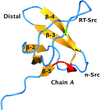issue contents
June 2020 issue

Cover illustration: Structure of heme d1-free cd1 nitrite reductase NirS [Klünemann & Blankenfeldt (2020), Acta Cryst. F76, 250-256].
research communications
Borrelia burgdorferi β-barrel assembly machinery A (BbBamA) is an essential translocator located in the outer membrane. The N-terminal periplasmic polypeptide-transport-associated (POTRA) domains of BbBamA are vital for assembly of the BAM complex. Here, the production, crystallization and initial X-ray crystallographic analysis of the three N-terminal POTRA domains of BbBamA (BbBamA-POTRA P1–P3) are reported.
Open  access
access
 access
accessClostridium difficile is a spore-forming bacterium and a leading cause of hospital-acquired antibiotic-associated diarrhoea. Symptoms of disease result from secreted toxins, while disease transmission is mediated via resistant endospores. CotE is a bifunctional spore-coat protein with peroxiredoxin and chitinase domains that are implicated in colonization. Here, the structure of the chitinase domain of CotE has been determined, revealing a GH18 family fold and, unexpectedly, a peptide bound in the active site.
Open  access
access
 access
accessThe crystal structure of a heme d1-free form of the cd1 nitrite reductase NirS from Pseudomonas aeruginosa has been determined and provides insight into a premature form of the enzyme.
The Tsp1 protein from Trichoderma virens is a novel protein with no homologous structures available in the Protein Data Bank. Recombinant Tsp1 protein was expressed and purified for the first time, its size and secondary structure were characterized and X-ray diffraction data were collected from crystals of the protein.
The crystal structure of the N-terminal SH3 domain of growth factor receptor-bound protein 2 was solved at 2.5 Å resolution.
PDB reference: Grb2 SH3N, 6sdf
The crystal structure of the C-type lectin SPL-1 complexed with N-acetylglucosamine and Ca2+ reveals Ca2+-mediated enhancement of the carbohydrate-binding affinity of SPL-1, which can recognize specific carbohydrates without Ca2+ in a manner distinct from that of ordinary C-type lectins.
PDB reference: SPL-1–GlcNAc complex, 6m5m
methods communications
Open  access
access
 access
accessThe first SFX diffraction from EGFP-μNS(448–605) crystals led to initial electron-density maps that allowed the clear identification of two EGFP molecules as well as of electron density for μNS(448–605). Determining the crystal structure of μNS using large XFELs in combination with compact light sources will be the first step towards determining the molecular basis of the role of μNS in the early stages of virus morphogenesis.


 journal menu
journal menu


















![[publBio]](/logos/publbio.gif)





